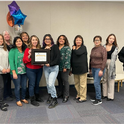Welcome!
The University of California Cooperative Extension Contra Costa County delivers high quality education and research programs that contribute to:
• Safe, healthy and accessible food
• Clean water and a healthy environment
• Improved nutrition habits and well-nourished residents
• Healthy youth who contribute to healthy communities
• An improved local economy
Our programs benefit ALL cities and ALL citizens throughout the County. We pride ourselves on delivering the most cost-effective programs in the most efficient manner by drawing upon experts from throughout the UC system, utilizing over 600 trained volunteers, and working cooperatively with over 150 diverse public and private agencies/organizations. And we do this at a minimal cost to the public.
BLOG
-

NPI partners with local health departments to support children’s healthy eating and active living through LEAP Awards program
Local Health Departments are improving their CFHL programs using the Nutrition Policy Institute's LEAP awards. Three hundred thirty-three schools and programs were recognized across California for making strides on health and wellness...
-

UC ANR partnership engages transitional housing residents in renovating therapeutic garden, growing fresh produce
CalFresh Healthy Living, UCCE and Master Gardeners in Alameda County promote healthy people and communities: Working with South County Homeless Project residents to grow fresh vegetables in a therapeutic green space. The Issue California...
-

Empowerment and Incentivization for Forest Management
Social Media Summary Protecting California's forests and building climate-resilient communities and ecosystems requires forest landowners, managers, and natural resource professionals to actively engage in stewardship. UC ANR's Forest Stewardship...
-

CalFresh Healthy Living, UCCE in Contra Costa County Empowers Teens to Promote Fruit & Vegetable Consumption
CalFresh Healthy Living (CFHL), University of California Cooperative Extension (UCCE) in Contra Costa County promotes healthy communities with a nutrition education curriculum designed to improve teens' eating and fitness choices. Of the 117 middle...
-

UC REC Collaboration Increases Student Awareness of Agricultural STEM Research and Practice Opportunities
Social media summary Upon touring field research sites, listening to talks, and engaging in hands-on activities at the Kearney Agricultural Research and Extension Center, 100% of undergraduate students reported learning more about agricultural...
Food Assistance during "Shelter-In-Place"
Need food? Here is a list of places to turn to...



Contact Information
Cooperative Extension
Contra Costa County
2380 Bisso Lane, Ste. B
Concord, CA 94520-4829
Main Office: 925-608-6670
Fax: 925-608-6697
Master Gardeners: 925-608-6683
4-H Program: 925-608-6690
Email: cecontracosta@ucdavis.edu
Nutrition Program
Contra Costa Stories
-
Can Clickers Improve the Nutrition Education Experience?
Nutrition education is an important part of improving the diets of Californians. Despite public awareness about the role of good dietary habits on health, most are not following the Dietary Guidelines for Americans. UC CalFresh, a University of California program, offers nutrition education to low-income families, youth, and seniors throughout California. The goal is to help people make healthy food choices within limited budgets. UC CalFresh educators collect evaluation data using paper forms, but about 25 percent of participants do not complete the forms, making it difficult to assess participants' intent to change their eating habits. Innovative strategies to collect data could help participants assess healthful food choices and recognize how they spend their food dollars.
-
UCCE helps low-income Californians increase food security
From 2007 to 2009, during the nation’s economic downturn, food insecurity in California’s low-income adult population increased from 35 percent to 40 percent. These adults were not able to procure sufficient food to maintain a healthy diet for themselves and other household members. Food insecurity effects academic achievement, increases the risk of obesity and chronic disease and impairs mental health. A 2012 UCLA Health Policy Brief reported that 38 million low-income adults in California were food insecure and that rates were highest in low-income Spanish-speaking households and those with children. Although participation in federal food assistance programs has increased since 2007, many recipients experience food resource management challenges, lacking skills to maximize their food dollars to buy, prepare and store healthy foods. Providing low-income families with food education along with resource management skills can help improve the overall health and food security of the household.
-
UCCE educators empower parents to limit children’s screen time
Today's children are expected to live shorter lifespans than their parents and childhood obesity is one contributing factor. The lifetime cost of obesity is estimated at $19,000 per child. Sugar- sweetened beverages (SSBs), fast foods, and screen time are factors related to unhealthy weight. Forty- two percent of Alameda and Contra Costa children are overweight or obese, 31% drank one or more SSB daily, and 24% ate fast food two or more times during the past week. Food companies spent $1.7 billion marketing unhealthy food to children and only $280 million marketing healthy foods. Children are exposed to food marketing through screen time, including TV, mobile devices, and computers. Educating parents about the benefits of serving their children healthy foods and beverages, reducing screen time, and encouraging family physical activity can contribute to better health outcomes and reduced health care costs.
-
UCCE facilitates teen conference about sexual exploitation of youth
More than 200 minors are actively being prostituted by 115 pimps in Oakland, according to the Oakland Police Department. Thanks to the Sexually Exploited Minors Network and Measure Y funding, a Safe Place Alternative is up and running in Oakland. Community-based organizations are working with police, the probation department, the district attorney’s office and other city and county offices to deal with the needs of sexually exploited children; however the network had not held a youth activity.
-
UC ANR teamed up to investigate effective integrated pest management for bed bugs in low-income, multiple-occupancy housing
Bed bugs, their bites, and the associated social stigma continue to plague many Californians and draw widespread attention from the media. Although bed bugs can occur within a wide range of human habitations and income-levels, it’s those who live in low-income, multiple-occupancy housing who appear to suffer the greatest. Integrated Pest Management (IPM), first developed by UC in the 1940s for agriculture, offers a theoretical framework for bed bug management in multiple-occupancy housing
-
Project 4-H2O Provides Free Zero Calorie Education and Option at Sugartown Festival
In Contra Costa County, the 2016 California Healthy Kids Survey found that only one out of four teens, ages 12-17, drank eight or more glasses of water the previous day. The same survey found that two out of three (62%) of teens drank two or more sodas the previous day - two times more teens than the national rate of 30%. Studies have found that Sugar Sweetened Beverages (SSBs) consumption is linked to weight gain, metabolic syndrome, tooth decay, and type 2 diabetes. Each 12 ounce soda contains the equivalent of eight teaspoons of added sugar, 130 calories, and zero nutrients. The American Heart Association recommends that children and teens limit added sugars to less than six teaspoons a day. Substituting zero calorie water for SSBs can help reduce added sugars, calories, and weight gain, ultimately reducing the risk of developing chronic diseases. Education and awareness are keys to helping individuals make informed choices. The annual Sugartown Festival in Crockett, CA is the largest community festival in the city drawing about 7,500 participants and provides an excellent opportunity to increase awareness.
-
Collaborative 4-H and Nutrition project identifies why teens are not drinking water at school
Childhood obesity remains an American epidemic – according to the Centers for Disease Control and Prevention, one out of every five children ages 6-19 is obese. Overweight and obese children are at increased risk of developing chronic disease, such as heart disease and diabetes, as well as social and psychological problems. The consumption of sugar-sweetened beverages (SSB’S) is one factor that contributes to obesity and research shows that substituting zero calorie water in place of SSB’s can help reduce weight gain. In Contra Costa County, 17% of youth ages 12-17 drank one or more soda the previous day. Recognizing a need to create a positive impact, Contra Costa County 4-H and Nutrition Family and Consumer Science (NFCS) Advisors collaborated to educate teens at John Swett High School (JSHS) in the Bay Area, where 55 percent of the teens qualify for free and reduced lunch.
-
EFNEP addresses childhood obesity through collaboration
Obesity in childhood increases a child’s risk of developing chronic disease, such as heart disease and diabetes, as well as social and psychological problems. Hayward, California, has the highest prevalence of overweight children in Alameda County’s 14 cities, and 50 percent of Hayward Unified School District’s students are overweight or obese. School-based education about healthy eating and fitness habits is a valuable tool to address this issue, but the school district lacked resources and staff needed to implement an evidence-based nutrition education program.
-
Incarcerated youth blossom while working with 4-H, Master Gardeners
Roughly 1 in 5 U.S. children have mental health problems, and only 20 percent to 25 percent receive treatment (CA Adolescent Health Collaborative, 2010). In the juvenile justice system, some studies report as many as two-thirds of adolescents have mental health disorders. Alameda County Probation's Camp Sweeney is an unlocked 24-hour facility serving boys aged 14 to 18 years. The teens at Camp Sweeney exhibit a range of maladaptive behaviors and have various physical and mental health needs, which should be treated as part of their rehabilitation.
-
UCCE Integrated Approach Increases Students' Water Consumption
Over the last four decades, rates of childhood obesity have more than tripled for school-aged youth. Sugar-sweetened beverage (SSB) intake contributes to excessive weight gain. Youth's risk for obesity increases an average of 60% with every additional daily serving of soda. In Shasta County 39% of children ages 2-17 consumed one or more SSBs daily and 33% were considered overweight or obese. The Dietary Guidelines for Americans encourage individuals to choose water as the best non-caloric substitute for SSBs. UCCE was ready to mobilize resources and partnerships to improve the health outcomes of Shasta County youth through education, marketing and promotion, and environmental changes that supported water consumption.
-
UCCE collaboration enhances students’ nutrition education experience
Poor food selection and inactivity contribute to the increase in childhood obesity rates and risk for chronic disease. Empowering school-age children to adopt a healthy lifestyle through nutrition and fitness education can help reverse this alarming trend. Schools are an ideal place for this education, but due to academic mandates it is often difficult to motivate educators to teach nutrition and fitness lessons. Teachers need something fun and creative to entice them to incorporate nutrition into their lesson plans.
-
2018 National Youth Summit on Agri-Science “opened eyes” of CA teens to how agricultural science applies to their daily lives
Youth today are confused about where their food comes from. Children have been quoted as saying cheese comes from plants and pasta from animals (Newsweek, 2017). This confusion is no surprise, as only two percent of Americans live on farms today, disconnected with food and agricultural production. Further, most of the youth today are not aware of the science of food, agriculture, and production, or the need for young people to consider careers in these fields. Creative minds are needed so that we can address the looming worldwide food shortages in the future.
-
Alameda 4-H improves the financial literacy of 4th and 5th-grade students
People develop financial attitudes and behaviors at an early age and today’s youth have significant spending power $211 billion a year in the US (http://www.statisticbrain.com/teenage-consumer-spending-statistics/). While youth are good at spending, various surveys on the financial literacy of teens, consistently report a grade of F or less than 69 percent. This issue is especially salient for limited-income youth and their families. From Tom Torlakson (California State Superintendent) to the US Mint, policy- makers, and organizations have been drawing attention to the need to equip young people to be the competent financial consumers and managers of tomorrow. Multiple groups have recently developed curriculums and programs to meet this need. However, many programs are not research-based, so it is unclear if they lead to financial literacy.
-
Children wash hands to prevent flu and other illness
In the United States, on average, more than 200,000 people are hospitalized and 36,000 people die from seasonal flu complications each year. To prevent the seasonal and H1N1 flu, the Centers for Disease Control recommends getting a flu vaccine and practicing everyday preventive actions, such as frequent handwashing. Handwashing is easy and the most important step to help prevent the spread of the flu. Yet research indicates that many adults and students do not practice frequent or proper handwashing. In fact, 1 out of 5 people do not wash their hands after using the restroom (American Society of Microbiology, 2005).
-
4-H youth practice healthy living
Obesity among 6- to 11-year-old youth has tripled over the past 30 years. Many youth and adults lack basic meal planning and food preparation skills. In a typical week in 2007, the number of dinners that were cooked and eaten at home was 4.8, but only 57 percent were prepared from scratch (Food Technology, 2008). Empowering youth and their families to adopt healthy food habits - such as planning, preparing and sharing meals at home - will improve the well-being of the entire household.
-
4-H Teens Become Role Models for Healthy Living
The poor health status for Bay Point youth and families is a result of multiple risk factors: unhealthy weight; sedentary behaviors; limited access to affordable, healthy food; poverty; substance abuse; crime; and poor school performance. Thirty-six percent of students are at an unhealthy weight. Of the nineteen teens that attend Gateway Continuation High School, 63% identify as Latino, and 90% are socioeconomically disadvantaged. Engaging at-risk teens in an after school healthy living program can empower them to improve their health status.
-
Bringing integrated pest management to schools
Since the enactment of the Healthy Schools Act (HSA) in 2001, both UC Cooperative Extension (UCCE) and the California Department of Pesticide Regulation (DPR) have been working with school districts in California to provide information about integrated pest management (IPM). The strategies employed in an IPM program include modifying horticultural practices, such as changing mowing heights and managing irrigation appropriately. These practices can reduce the amount of pesticides used on school grounds to help schools to meet the standards of the HSA and provide a safe and healthy environment for students, teachers and staff. DPR has coordinated numerous workshops for school districts covering general landscape and building IPM topics. However, attendees requested more detailed training about turf IPM since they manage turf areas like playgrounds and sports fields. UCCE has extensive experience in this area and was called upon to help schools implement this policy.
Spotlight Stories
-
-
-
-
A ton of vegetables!
A TON OF VEGETABLES!
The Master Gardeners donated 2,000 pounds of fresh vegetables to the Monument Crisis Center for distribution to families.
